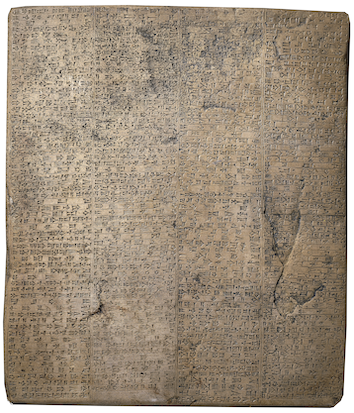Etila (temple of Gula/Ninkarrak at Borsippa)
According to Akkadian inscriptions of the Neo-Babylonian ruler Nebuchadnezzar II (r. 604–562 BC), including the "East India House Inscription," the healing goddess Gula/Ninkarrak had three temples at Borsippa. Etila was one of those three; the other two were Egula and Ezibatila.

BM 129397, a large stone tablet that bears a long Akkadian inscription that is now commonly referred to as the "East India House Inscription." The description of Nebuchadnezzar's rebuilding of Etila is recorded in lines iv 52–56. Image adapted from the British Museum Collection website. Credit: Trustees of the British Museum.
Names and Spellings
This temple at Borsippa went by the Sumerian ceremonial name Etila, which means "House Which Gives Life."
- Written Forms: e₂-ti-la.
Known Builders
- Neo-Assyrian (ca. 911–612 BC)
- Esarhaddon (r. 680–669 BC)
- Neo-Babylonian (ca. 625–539 BC)
- Nebuchadnezzar II (r. 604–562 BC)
Building History
A fragmentarily-preserved Akkadian inscription of the Neo-Assyrian king Esarhaddon records that he repaired a Gula temple at Borsippa after it had been damaged by water. Due to the text's bad state of preservation, it is not entirely certain that this ruler restored Etila and not one of the other two Gula temples at Borsippa. Esarhaddon is tentatively regarded on BTMAo as a known builder of this temple, although this cannot presently be proven with certainty.
In numerous Akkadian inscriptions, Nebuchadnezzar II states that he built Etila anew. This work was carried out in connection with the rebuilding of two other temples of Gula/Ninkarrak at Borsippa, Egula and Ezibatila. Several still-fragmentarily-preserved texts discovered at Borsippa record additional details about the project. One inscription, which is written on a two-column clay cylinder, describes the earliest stages of Etila's rebuilding as follows:
Presumably, after relaying the foundations on their original positions, Nebuchadnezzar's workmen built the temple's brick superstructure anew, roofed it, and decorated it interior. Those building stages are not recorded in presently-known inscriptions.
Archaeological Remains
Etila has not yet been positively identified in the archaeological record.
Further Reading
- George, A.R. 1993. House Most High. The Temples of Ancient Mesopotamia (Mesopotamian Civilizations 5), Winona Lake, p. 150 no. 1095.
Jamie Novotny & Joshua Meynell
Jamie Novotny & Joshua Meynell, 'Etila (temple of Gula/Ninkarrak at Borsippa)', Babylonian Temples and Monumental Architecture online (BTMAo), The BTMAo Project, a sub-project of MOCCI, [http://oracc.org/btmao/Borsippa/TemplesandZiggurat/Etila/]